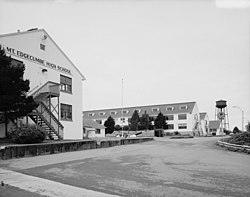Sitka Naval Operating Base and U.S. Army Coastal Defenses
|
Sitka Naval Operating Base and US Army Coastal Defenses
|
|
|
Alaska Heritage Resources Survey
|
|

Headquarters and barracks buildings at the base
|
|
| Location | Japonski Island, Makhnati Island and the causeway connecting them |
|---|---|
| Nearest city | Sitka, Alaska |
| Coordinates | 57°02′58″N 135°21′35″W / 57.04941°N 135.35963°WCoordinates: 57°02′58″N 135°21′35″W / 57.04941°N 135.35963°W |
| Area | 510 acres (210 ha) |
| Built | 1939 |
| Built by | US Navy Seabees |
| NRHP Reference # | 86003559 |
| AHRS # | SIT-029 |
| Significant dates | |
| Added to NRHP | August 11, 1986 |
| Designated NHLD | August 11, 1986 |
The Sitka Naval Operating Base and U.S. Army Coastal Defenses are the surviving elements of the World War II-era defenses and defense establishments in and around Sitka, Alaska. These facilities, in particular the airfields and naval bases, played a key role in the defense of Alaska, and in military operations against Japanese forces which occupied Attu and Kiska, two remote islands in the Aleutian chain. The Sitka facilities were designated a National Historic Landmark in 1986.
In consideration of the possibility of war in the Pacific Ocean, the United States War Department in 1937 established a small naval station near Sitka, Alaska as a base for a small fleet of PBY Catalina seaplanes. In 1939 Congress appropriate funds for the construction of naval air stations at Sitka and other sites in coastal Alaska. The Sitka station was built on Japonski Island , just west of Sikta Harbor, on land that had been under United States Navy jurisdiction since the Alaska Purchase in 1867. The Sitka Naval Air Station was formally commissioned on October 1, 1939. What was then not much more than a coal resupply station rapidly grew, with a radio station, barracks, and other facilities constructed, mainly on the north side of the island. In March 1941 United States Army forces arrived in Sitka, and began construction of a coastal defense battery on Makhnati Island, an islet at the western end of a chain of islets extending westward from Japonski Island. To facilitate this work, a causeway 8,100 feet (2,500 m) in length was constructed connecting Japonski to Mahknati via this island chain. These facilities were the only significant American military facilities in the North Pacific when the Japanese bombed Pearl Harbor in December 1941, even though they were still a work in progress.
...
Wikipedia

